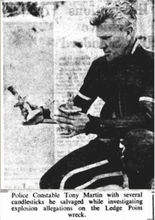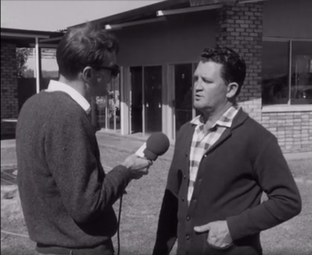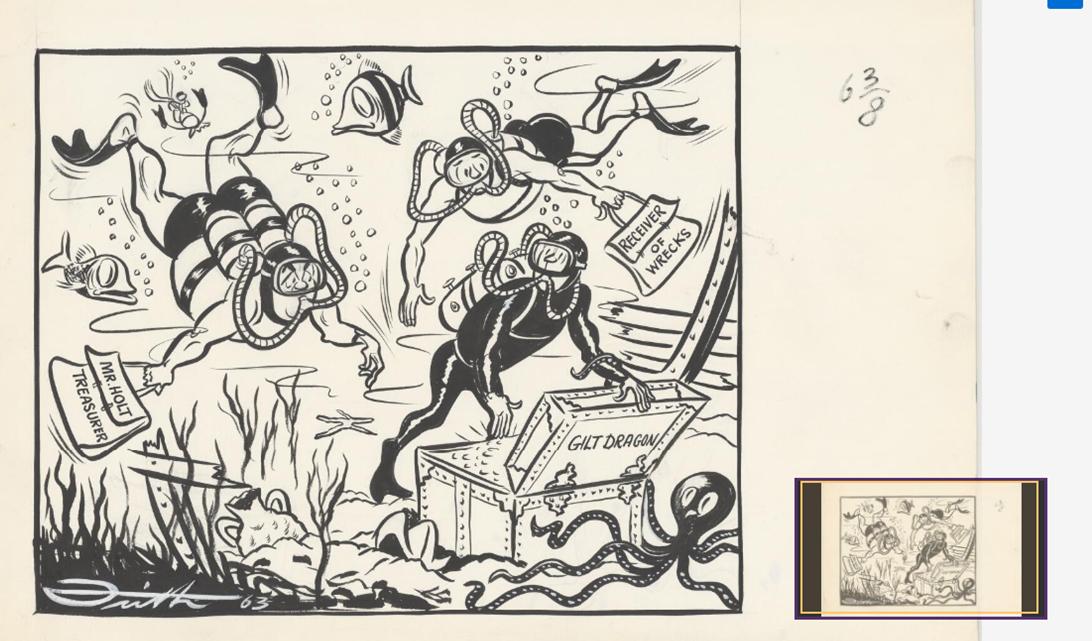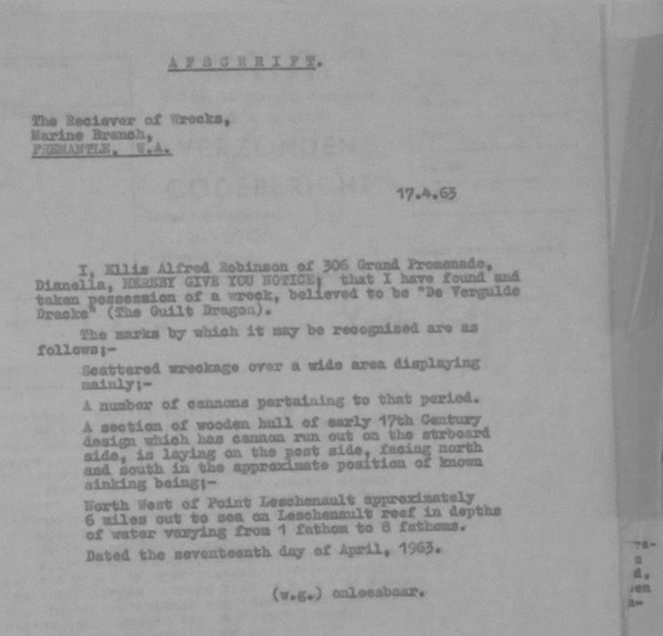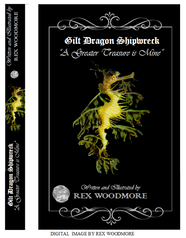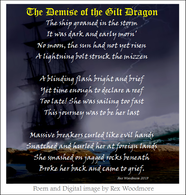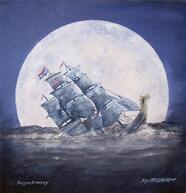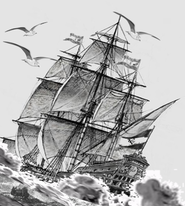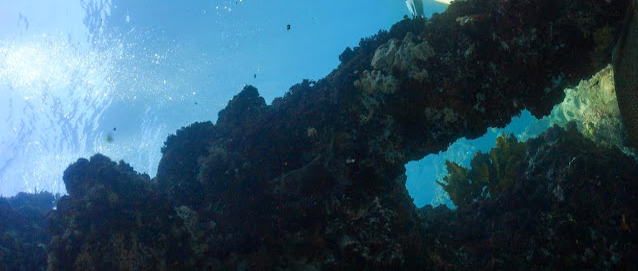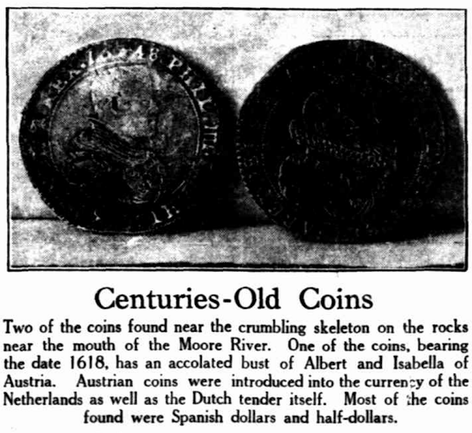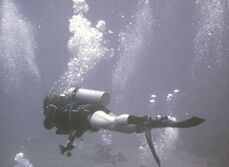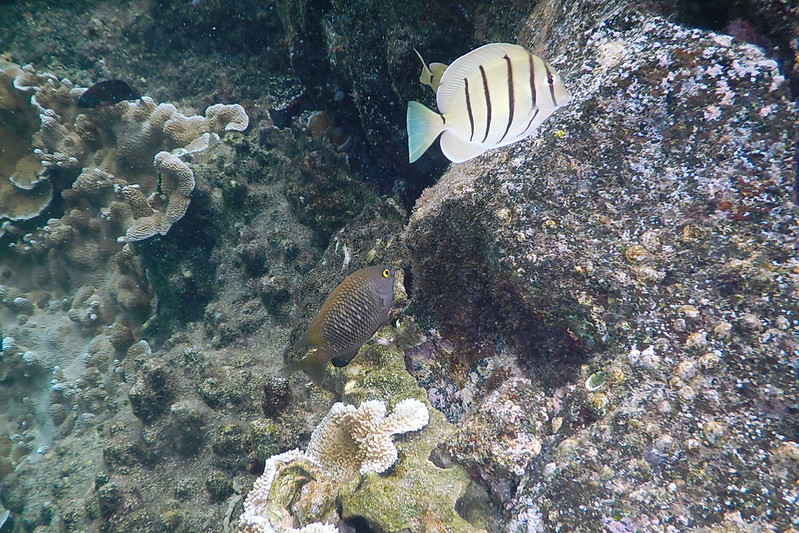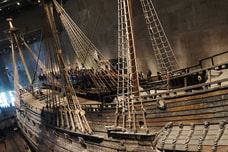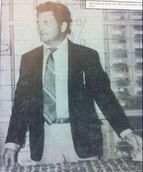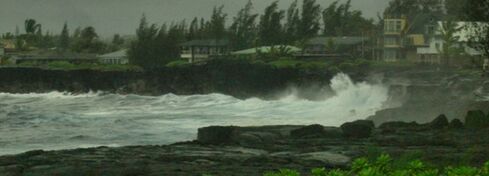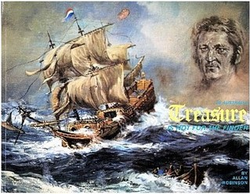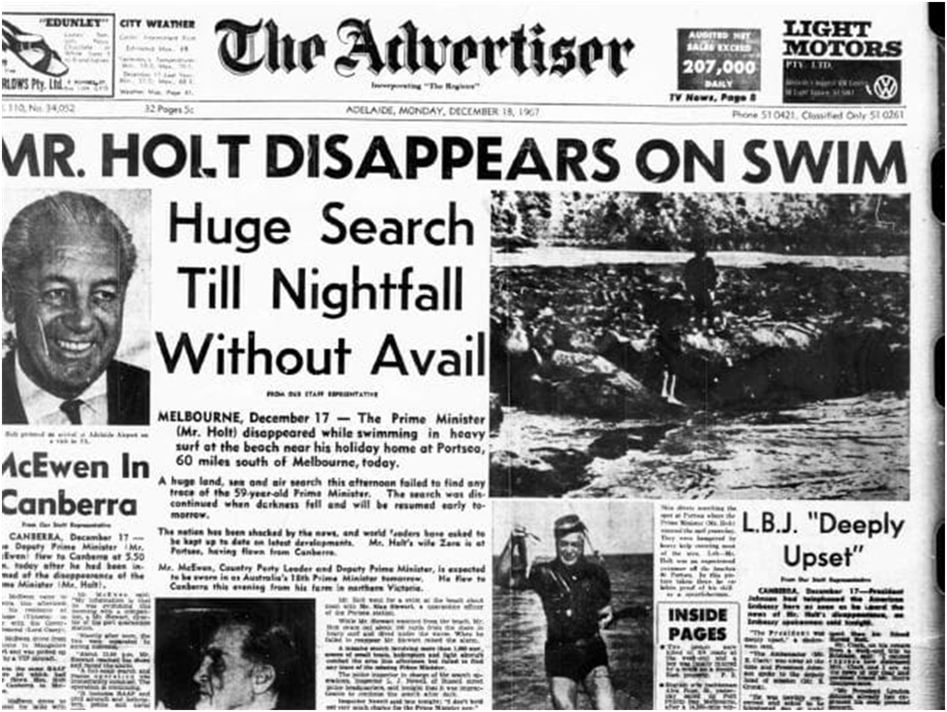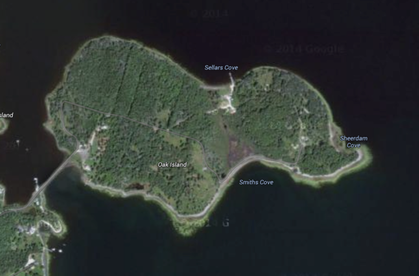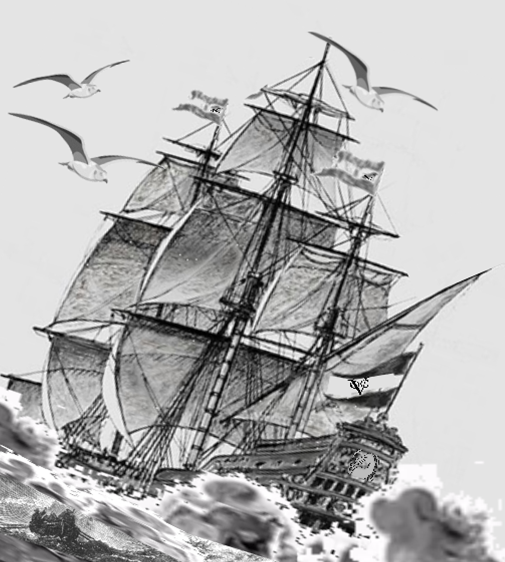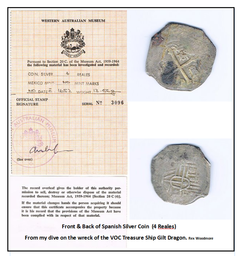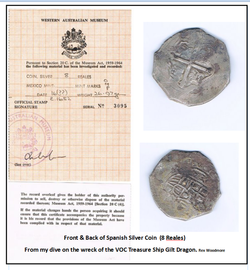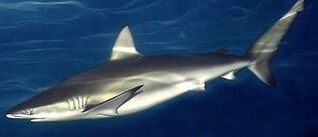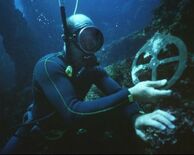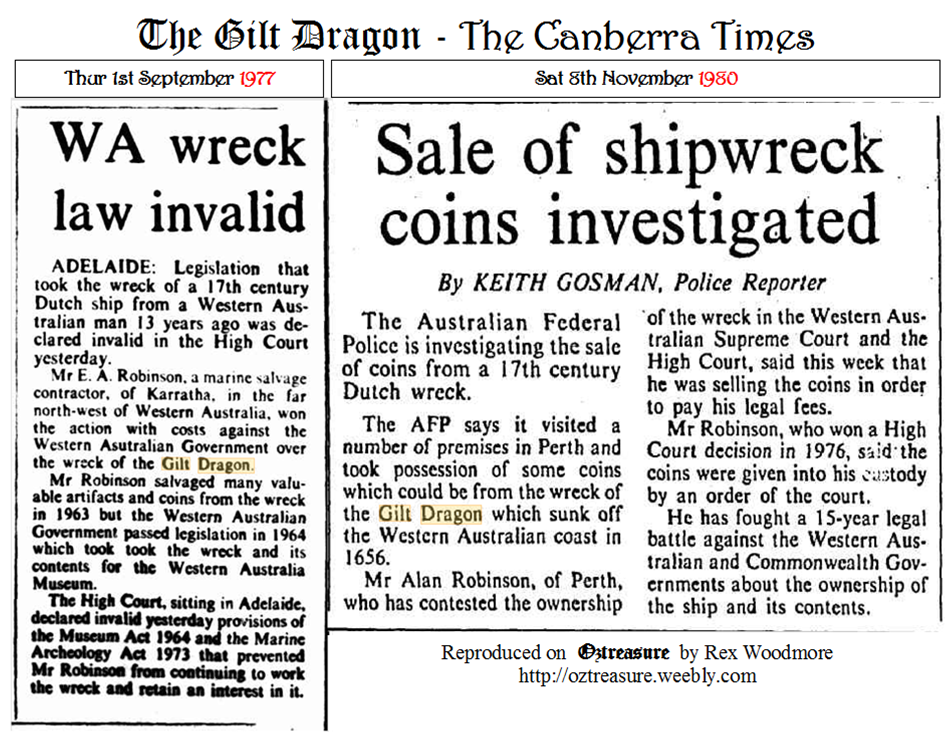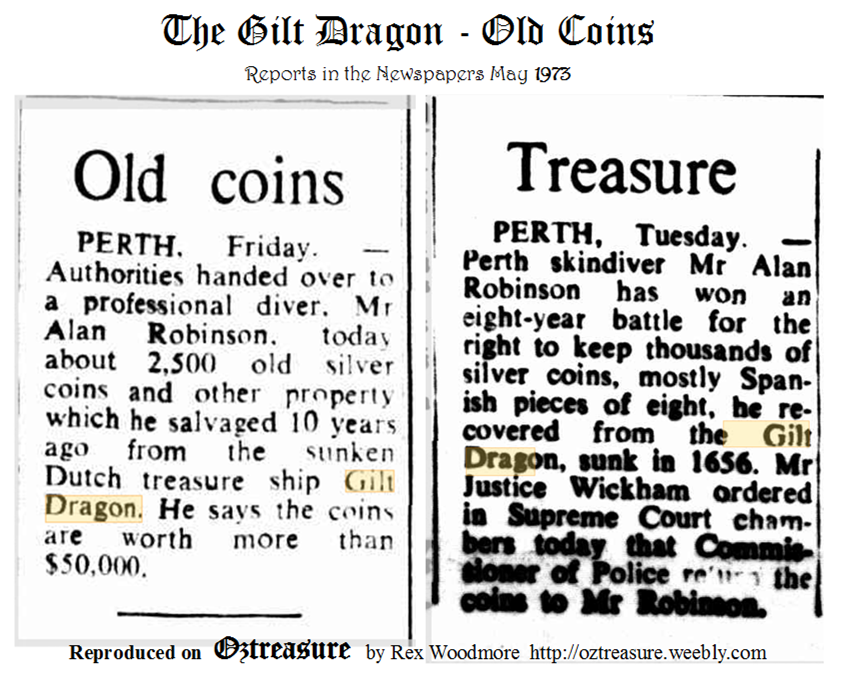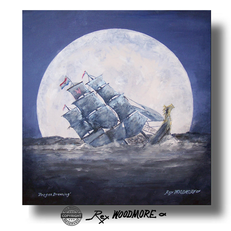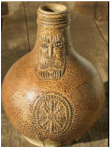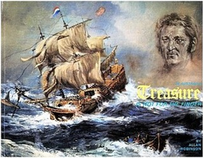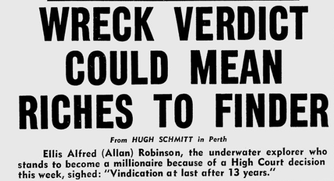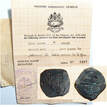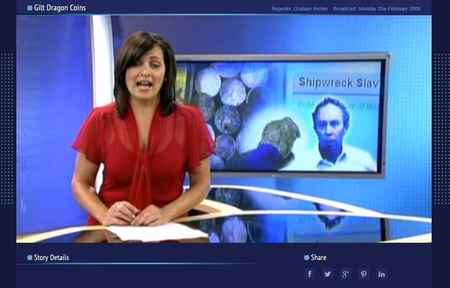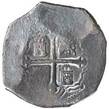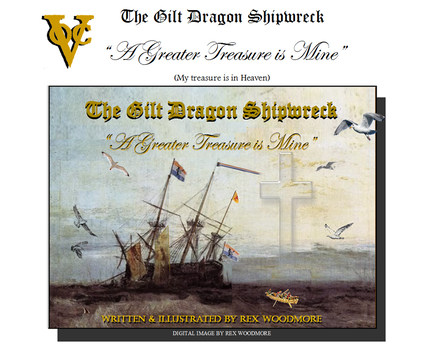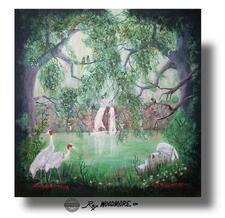'Treasure Treachery and Power of the Media'
1977 ALLAN ROBINSON WINS THE COURT BATTLE
Happy to give treasure to the Commonwealth and "the people"
He gets home to find- GILT DRAGON ARTIFACTS STOLEN
1977 5th Dec. CANBERRA TIMES Shipwreck artifacts stolen: explorer
Artifacts from the Gilt Dragon — said to be worth about $150,000 — have been stolen from the Karratha office of underwater explorer Mr. Alan Robinson.
Mr. Robinson, who discovered the 311-year-old Dutch wreck,
120 kilometes north of Fremantle and retrieved many valuable
items from it in 1963, reported the loss to the police on Satur-
day. He said the haul included a bellaramine jug — worth about
$100,000 as a collector's piece— a set of three coins in a Gilt
Dragon folder, a sailor's belt buckle, four pieces of lead
musket shot, and a pair of ship's dividers.
Mr. Robinson, who last week won a High Court action against
the Western Australian Government over his right to continue
working the wreck off LedgePoint, and to retain an interest in
it, said that the stolen artifacts would be of no value to the
thieves.
The High Court ruled invalid legislation giving control of the
wreck to the Western Australian Museum.
On Saturday a proclamation was made by the Federal Gov-
ernment declaring that the Commonwealth Historic Shipwrecks
Act 1976 applied to the Western Australian coast, including the
Gilt Dragon. Mr. Robinson, elated by the High Court decision, said that he
was happy for the wreck and its treasure to be turned over to the
Commonwealth and "the people of Australia".
Artifacts from the Gilt Dragon — said to be worth about $150,000 — have been stolen from the Karratha office of underwater explorer Mr. Alan Robinson.
Mr. Robinson, who discovered the 311-year-old Dutch wreck,
120 kilometes north of Fremantle and retrieved many valuable
items from it in 1963, reported the loss to the police on Satur-
day. He said the haul included a bellaramine jug — worth about
$100,000 as a collector's piece— a set of three coins in a Gilt
Dragon folder, a sailor's belt buckle, four pieces of lead
musket shot, and a pair of ship's dividers.
Mr. Robinson, who last week won a High Court action against
the Western Australian Government over his right to continue
working the wreck off LedgePoint, and to retain an interest in
it, said that the stolen artifacts would be of no value to the
thieves.
The High Court ruled invalid legislation giving control of the
wreck to the Western Australian Museum.
On Saturday a proclamation was made by the Federal Gov-
ernment declaring that the Commonwealth Historic Shipwrecks
Act 1976 applied to the Western Australian coast, including the
Gilt Dragon. Mr. Robinson, elated by the High Court decision, said that he
was happy for the wreck and its treasure to be turned over to the
Commonwealth and "the people of Australia".
In a Government sponsored video presentation, a leading public maritime archaeologist once said:
“People write for an awful lot of reasons and ‘unofficial’ accounts are often the Truest"
I’m glad he made that statement, because my ‘unofficial account' may not always be in accord with ‘official’ accounts published by the institution he works for. However in this instance, I agree with him and hope the reader of my ‘unofficial’ account finds it to be not just the 'truest' but the actual truth of events surrounding the discovery of the Gilt Dragon in the late 1950's and 1960's a time in WA of: 'Treasure, Treachery and The power of the media'
“People write for an awful lot of reasons and ‘unofficial’ accounts are often the Truest"
I’m glad he made that statement, because my ‘unofficial account' may not always be in accord with ‘official’ accounts published by the institution he works for. However in this instance, I agree with him and hope the reader of my ‘unofficial’ account finds it to be not just the 'truest' but the actual truth of events surrounding the discovery of the Gilt Dragon in the late 1950's and 1960's a time in WA of: 'Treasure, Treachery and The power of the media'
ALLAN ROBINSON'S SALVAGE RIGHTS
The Gilt Dragon and Her Treasure
REX WOODMORE COMMENTS
In the 60's the UEC (Underwater Explorers Club of WA ) trained Police divers at a jetty in Naval Base W.A. (The jetty has since been destroyed by a storm and replaced with a groin.)
Allan Robinson a marine salvage expert was one of my dive instructors and also the UEC's Secretary. Allan won the the salvage rights to the Gilt Dragon's treasure and he delighted in taking people to dive on the wreck with him.
He invited the Police divers to dive on the wreck and as always, he encouraged his dive buddies to souvenir a few coins. So I guess they all had a few trophies, quite legally and above board, from the dive. With they were seeing where the wreck was,they said that as it was out of the 3 mile territorial limit the Police would have no jurisdiction over the wreck .
The museum intended to ask them to guard the wreck , but the police either wouldn't or couldn't (having already dived on it, they may have felt compromised) but when boat loads of looters where using explosives and fighting with each other one Police diver was assigned to keep the peace.
|
DIVER POLICE SGT. TONY MARTIN
The wreck of the Gilt Dragon was just out of the 3 mile territorial water limit and therefore, in those days, before the the boundary further out to sea, the Government and WA Police had no jurisdiction over the site. In the following interview, notice how Police Sergeant Tony Martin witnessed and reported that many people were looting artifacts from the Gilt Dragon. |
NOTE: Sgt. Martin does not refer to Allan Robinson as a Looter and he does not accuse Allan of any wrong doing. Why? Because as he said "...it was a matter of conjecture whether we had authority there.
THE WRECK WAS IN INTERNATIONAL WATERS
The wreck was considered to be in International waters (that was until Before the Government 'moved the goal posts' and introduced laws that took Allan's salvage rights from him).
Later it was ruled by a magistrate that the newly introduced shipwreck law was invalid.
Even the police sergeant, Tony Martin, suggests that the police may not have had jurisdiction over the wreck that he dived on.
(Note Allan fought for the truth and won every charge laid against him).
So I ask:
"Why was it that Allan Robinson (who at the time had the salvage rights issued by the receiver of wrecks in WA) was accused of looting".
The answer is simple
" Nasty, jealous people who told lies either to promote their own importance or for the sake of their journalistic careers.
Others suppressed the truth and went along with the lies, either because they were told to by their superiors in the museum and other Government departments or because they feared that they too would be tarred with the same brush as Allan was tarred with! Then their were the blissfully ignorant people in the street who were conned (and still are being) by what we would now call 'false news'
Later it was ruled by a magistrate that the newly introduced shipwreck law was invalid.
Even the police sergeant, Tony Martin, suggests that the police may not have had jurisdiction over the wreck that he dived on.
(Note Allan fought for the truth and won every charge laid against him).
So I ask:
"Why was it that Allan Robinson (who at the time had the salvage rights issued by the receiver of wrecks in WA) was accused of looting".
The answer is simple
" Nasty, jealous people who told lies either to promote their own importance or for the sake of their journalistic careers.
Others suppressed the truth and went along with the lies, either because they were told to by their superiors in the museum and other Government departments or because they feared that they too would be tarred with the same brush as Allan was tarred with! Then their were the blissfully ignorant people in the street who were conned (and still are being) by what we would now call 'false news'
|
BELOW:
1994 EXCERPT FROM INTERVIEW WITH POLICE DIVER TONY MARTIN. Date of interview: 28 October 1994 Conducted by Gillian O’Mara When Gillian O’Mara asked Sgt. Martin if he had dived on shipwrecks: MARTIN Oh yes. I had an occasion to dive on the Gilt Dragon. As a matter of fact, I was very involved with that at the outset with Jim Henderson who’s son actually located those elephant tusks. He was the original founder of it but it was a person by the name of Alan Robinson tried to take the credit for finding the wreck but it was not so and I was very heavily involved in that situation. As a matter of fact when the parties up there were salvaging, there’s a lot of coins involved in it, a lot of silver coins and a lot of treasures and, of course, Jim Henderson’s party would they were getting these particular relics to the museum and this other party was getting the silver coins for their own personal gain and, of course, there were restrictions out there and they would fight. |
As a matter of fact it got rather vicious and I was instructed to go down and maintain order so it was my job to go out there underwater and maintain the peace under the sea and if anything happened then I administered justice. Although at the time it was three miles out to sea and it was a matter of conjecture whether we had authority there to or not but anyhow I took the risk and sort of went out there and kept the peace underwater but unfortunately on one occasion one party there didn’t want me to be there. I was an obstructionist. They didn’t want me there at all because I was a witness to what was going on, keeping law and order and while I was cruising between the two opposing parties, just slowly swimming up and down I went into a cave and I was fossicking around there looking for parts of the wreck and all of a sudden my mouthpiece was violently torn from my mouth and I was left with the rubber. Just as I was about to do some heavy lifting and at the time water came into my lungs and I started to cough. I had no air line and I was in trouble and I managed to get to the surface where the waves were breaking on the rocks at the time and by having this water in your lungs and that you sort of get very weak and I was in real strife. And anyhow Jim Henderson noticed the difficulty and gave me a hand to get back to the boat and after about five or ten minutes I coughed up all this water and I managed to get another valve and go and resume my duties. But I could see that somebody – I always had an orange coloured air line. All the rest of them had a dark coloured one – grey or black so anybody who saw that bright orange air line would know that I was at the end of it and I presumed that somebody there didn’t want me there who grabbed it and pulled it out hoping that would be a lesson to me or hoping that I’d get into trouble, so it was attempt actually to almost to kill you because one of the parties there didn’t want me there for sure. I always stopped them from doing what they wanted to do because I was keeping an eye on the whole lot of them.
INT When you say that you were near the rocks, what part of the coastline are you talking about?
MARTIN Well that’s up, it’s after the - I don’t know exactly, it’s after the I just don’t know the name of the area where it is but it’s up near Lancelin somewhere – from between south of Lancelin and about three miles out to sea and there just where the ship, the Gilt Dragon must have hit this reef and it’s a very treacherous area and I can understand how these people must have panicked there because you’re about two or three miles from the shore, to hit this reef and the boat would disintegrate. It must have been terrible. But there are outcrops of rock right along that coast. It’s one of the most treacherous coastlines in the world I understand because everywhere you go there’s rocky outcrops and there’s no indication that you’re coming across them and I can imagine in the early days that all these people who hit these wrecks would have been a shock to them because they wouldn’t have been chartered ..........
INT When you say that you were near the rocks, what part of the coastline are you talking about?
MARTIN Well that’s up, it’s after the - I don’t know exactly, it’s after the I just don’t know the name of the area where it is but it’s up near Lancelin somewhere – from between south of Lancelin and about three miles out to sea and there just where the ship, the Gilt Dragon must have hit this reef and it’s a very treacherous area and I can understand how these people must have panicked there because you’re about two or three miles from the shore, to hit this reef and the boat would disintegrate. It must have been terrible. But there are outcrops of rock right along that coast. It’s one of the most treacherous coastlines in the world I understand because everywhere you go there’s rocky outcrops and there’s no indication that you’re coming across them and I can imagine in the early days that all these people who hit these wrecks would have been a shock to them because they wouldn’t have been chartered ..........
ALLAN ROBINSON DONATED COINS TO A LIBRARY
(He never knew they'd mock him as a Pirate & Looter!)
A LOOTER WOULD NOT DONATE HIS LOOT
The State Library of Western Australia holds a small collection of Dutch coins that tell an extraordinary story. Librarian Peter Edwards shares the incredible story of this sunken treasure that has made its way through the years to find a home in the State Library’s rare collections. https://soundcloud.com/tags/alan%20robinson
The coins come from the 1656 wreck near Ledge Point of the Dutch ship the Gilt Dragon The coins from the Gilt Dragon were donated by Alan Robinson, in 1968, and those from the Zeewijk were donated to the Library by Dominic Serventy in 1999.
The coins come from the 1656 wreck near Ledge Point of the Dutch ship the Gilt Dragon The coins from the Gilt Dragon were donated by Alan Robinson, in 1968, and those from the Zeewijk were donated to the Library by Dominic Serventy in 1999.
NEWS 27th November 2022
Musket balls from Gilt Dragon found on the beach.
|
In 1656 a Dutch ship, the Gilt Dragon, was shipwrecked off the west coast of Australia. The survivors and the treasure they brought ashore vanished without trace. Earlier this year some campers fossicking along the shoreline made an amazing discovery, raising hopes of solving one of the nation's great maritime mysteries.
|
|
NEWS 24th November 2022
Allan Robinson was right when he said
"In Australia, treasure is not for the finder!"
Gilt Dragon and the receiver of wrecks, https://nla.gov.au/nla.obj-153024091/view
BELOW: BELIEVED TO BE GENUINE 17th APRIL 1963
ALLAN ROBINSON'S REPORT TO THE WA RECEIVER OF WRECKS
Allan Robinson had the legal right to salvage the Gilt Dragon's treasure
ALLAN ROBINSON'S REPORT TO THE WA RECEIVER OF WRECKS
Allan Robinson had the legal right to salvage the Gilt Dragon's treasure
|
Allan Robinson Had the Salvage Rights!
In 1973 The court agreed that Allan Robinson had the legal right to a batch of confiscated coins from the Gilt Dragon and orders the CIB to return them to him. In 1973 worth $50.000 (In WA he could have bought two suburban houses for that much) In 2021, these 2,500 Gilt Dragon coins could be worth well over a couple of $million. |
|
The beautiful, golden leafy sea dragon was so well camouflaged on the reef in the weeds, that as I looked away, it vanished.
Memories are like dragons. No matter how beautiful they are they disappear only to reapear, time and time again, as one ages and savours ones life's experiences, both beautiful and grotesque. |
I have a story to tell of another golden dragon, her name, given to her in the Netherlands 365 years ago, is ‘De Vergulde Draak’ (The Gilt Dragon). When I was introduced to her, she was a well camouflaged shipwreck, guarding her treasure, hidden on the reef in the weeds.
Now that I’m past my ‘Youth by date’ of three score and ten, I recognise a greater treasure is mine, awaiting me in Heaven.
Before my memories vanish from my mind, like the dragon and her treasure, have vanished from the reef, I should write a book!
But can I be bothered?
Before my memories vanish from my mind, like the dragon and her treasure, have vanished from the reef, I should write a book!
But can I be bothered?
DEMISE of the GILT DRAGON
|
April 1656, sailing at full speed during a storm, in the dark, the VOC Vergulde Draak (Gilt Dragon) crashed and broke her back on a submerged limestone reef, on the coast near Ledge Point in W.A.
The Demise of the Gilt Dragon
|
|
On board were 193 crewmen, officers, soldiers, merchants and adventurers of many nationalities (118 drowned). In the splintered debris there lay many large Iron canon, a bronze swivel gun, Elephant tusks, hundreds of ballast bricks, Earthenware jugs and eight chests of silver coins.
|
“Pieces of Eight, Pieces of Eight’.
The wreck and treasure was discovered 300 years later by Allan Robinson the man to whom I owe my life. While diving on the treasure of the Gilt Dragon, I was smashed time and time again, onto the same jagged rocks, as those that broke the back of the ship. Then a three meter shark circled and ‘sniffed’ at my bleeding legs.
I called for help to the God I was unsure I believed in and Allan Robinson without hesitation risked his life to save mine.
“Greater love has no one than this, than to lay down one’s life for his friends.” John 15:13
I called for help to the God I was unsure I believed in and Allan Robinson without hesitation risked his life to save mine.
“Greater love has no one than this, than to lay down one’s life for his friends.” John 15:13
A shipwreck was found and lost again.
Finding the Gilt Dragon- The untold true account! 1957.
Two spear fishermen, one a sales manager, Allan Robinson, and the other a student called Bruce, met at a spear fishing championship where they did well and got to know a journalist who was very interested in what they did.
The two spear fishermen became regular diving buddies. One day they were approached by a Cray fisherman with a proposition to use his boat in the Cray fishing off season, to go line fishing and Spear fishing for snapper (A fish highly prized by Fish & Chip shops and restaurants) On their first venture out together (Well before the days of GPS) the Skipper had trouble finding the exact spot he had in mind for fishing. Then just over 3 miles (about 5klms) out to sea, they found an unusual shaped submerged reef, with schools of big Dhu fish that drifted in and out of the unusual holes and caves.
Two spear fishermen, one a sales manager, Allan Robinson, and the other a student called Bruce, met at a spear fishing championship where they did well and got to know a journalist who was very interested in what they did.
The two spear fishermen became regular diving buddies. One day they were approached by a Cray fisherman with a proposition to use his boat in the Cray fishing off season, to go line fishing and Spear fishing for snapper (A fish highly prized by Fish & Chip shops and restaurants) On their first venture out together (Well before the days of GPS) the Skipper had trouble finding the exact spot he had in mind for fishing. Then just over 3 miles (about 5klms) out to sea, they found an unusual shaped submerged reef, with schools of big Dhu fish that drifted in and out of the unusual holes and caves.
On that day the three men were very successful with their fishing, but the weather changed and huge waves rolled in so they headed home through very choppy waters.
Soon after the two divers arrived back at Allan’s house in Dianella, their journalist friend knocked on the door. His boss had sent him to get another story from the Spearfishing guys he knew (Spearfishing was a relatively new sport in Western Australia and the public craved stories about it).
While talking about big fish on the unusual shaped reef, the strange cylindrical weed covered rocks they had seen there, were mentioned and the wide eyed reporter said “It could be an old wreck with cannons. I’ll find out if any have been reported” With that he rushed off. Allan and Bruce’s reaction was like
“Cannons? Yeh! Sure! Whatever! But it still looks like rocks to us” The two experienced divers were familiar with iron shipwrecks, but not decayed and petrified 17th Century timber ships with cannons that looked like cylindrical rocks.
Soon after the two divers arrived back at Allan’s house in Dianella, their journalist friend knocked on the door. His boss had sent him to get another story from the Spearfishing guys he knew (Spearfishing was a relatively new sport in Western Australia and the public craved stories about it).
While talking about big fish on the unusual shaped reef, the strange cylindrical weed covered rocks they had seen there, were mentioned and the wide eyed reporter said “It could be an old wreck with cannons. I’ll find out if any have been reported” With that he rushed off. Allan and Bruce’s reaction was like
“Cannons? Yeh! Sure! Whatever! But it still looks like rocks to us” The two experienced divers were familiar with iron shipwrecks, but not decayed and petrified 17th Century timber ships with cannons that looked like cylindrical rocks.
In the newspaper archives the Journalist found plenty of information about a 1656 Dutch shipwreck and treasure suspected in that area. There were also 1931 reports of crumbling skeletons of Europeans found in caves with a few coins with dates that fitted with the wreck.
And there was a circle of stones on the ground believed to be a sign to where the treasure was buried. Many had searched without success.
There was also a very big mast known to be on the beach at the base of big sand dunes.
(Believe it or not, my friends and I saw the huge mast on the beach when I was about 17. It lay there ignored for years until 4WD vehicles and chainsaws were common and it was sadly, cut up for firewood).
The next day, after much research, the reporter and his boss were so convinced it was the Gilt Dragon that they sent a car to pick up Allan from work and Bruce from school to bring them to Newspaper house.
When the bewildered duo arrived, they were greeted like astronauts, returning after landing on the moon. Cameras flashed, microphones shoved in their faces and surrounded by excited newspaper staff, all reaching out to congratulate Allan and Bruce, for their incredible find of the famous lost treasure of the Gilt Dragon. It was quite embarrassing for the two reluctant heroes. In loyalty to their journalist friend, they didn’t want to say it the way it really was and burst his bubble in front of his friends, colleagues and employers.
Allan Robinson had read about the Gilt Dragon, but that was the extent of his knowledge. All he knew was that they had glimpsed some unusual shapes they dismissed as weed covered limestone.
By the time they walked out of the office, they had signed a declaration with the receiver of wrecks and were committed to go, almost the next day, on a newspaper funded photographic trip to the site. Outside in the street they were greeted by a News boy shouting
There was also a very big mast known to be on the beach at the base of big sand dunes.
(Believe it or not, my friends and I saw the huge mast on the beach when I was about 17. It lay there ignored for years until 4WD vehicles and chainsaws were common and it was sadly, cut up for firewood).
The next day, after much research, the reporter and his boss were so convinced it was the Gilt Dragon that they sent a car to pick up Allan from work and Bruce from school to bring them to Newspaper house.
When the bewildered duo arrived, they were greeted like astronauts, returning after landing on the moon. Cameras flashed, microphones shoved in their faces and surrounded by excited newspaper staff, all reaching out to congratulate Allan and Bruce, for their incredible find of the famous lost treasure of the Gilt Dragon. It was quite embarrassing for the two reluctant heroes. In loyalty to their journalist friend, they didn’t want to say it the way it really was and burst his bubble in front of his friends, colleagues and employers.
Allan Robinson had read about the Gilt Dragon, but that was the extent of his knowledge. All he knew was that they had glimpsed some unusual shapes they dismissed as weed covered limestone.
By the time they walked out of the office, they had signed a declaration with the receiver of wrecks and were committed to go, almost the next day, on a newspaper funded photographic trip to the site. Outside in the street they were greeted by a News boy shouting
“Daily News! Skindivers find shipwreck treasure".
Allan and Bruce were handed copies of the 'Daily News' with a story from the over imaginative mind of their journalist friend:
Allan and Bruce were handed copies of the 'Daily News' with a story from the over imaginative mind of their journalist friend:
“Allan Robinson, the skin-diver from Perth who led the party which found the ancient wreck, is negotiating for the salvage rights”
Allan and Bruce were overwhelmed by it all.
Allan and Bruce were overwhelmed by it all.
The next day when the expedition team arrived at the Lancelin pub they were greeted by the Skipper of the Cray boat who said
“I hope for all your sake's I can find the spot again!”
The News paper team were all stunned. In their excitement and haste, they hadn’t thought about that! Or about the weather which by now was too bad to dive until several days later.
In the interim, while waiting for better weather, the Daily News, while selling their story around the world, had to keep it rolling with creative sensational claims. The delay had the conspiracy theorists saying "The skipper wants to keep the wreck to himself, so he is pretending to not know the exact location" But that was not true! When the weather eventually improved, the wreck couldn’t be found.
The reporter’s job was in jeopardy, so the two divers were given a hacksaw and without being told why, were asked to pose for photos next to a natural limestone solution pipe.
“I hope for all your sake's I can find the spot again!”
The News paper team were all stunned. In their excitement and haste, they hadn’t thought about that! Or about the weather which by now was too bad to dive until several days later.
In the interim, while waiting for better weather, the Daily News, while selling their story around the world, had to keep it rolling with creative sensational claims. The delay had the conspiracy theorists saying "The skipper wants to keep the wreck to himself, so he is pretending to not know the exact location" But that was not true! When the weather eventually improved, the wreck couldn’t be found.
The reporter’s job was in jeopardy, so the two divers were given a hacksaw and without being told why, were asked to pose for photos next to a natural limestone solution pipe.
Everyone laughed and the lifelong ridicule of my friend and diving mentor, Allan Robinson had begun.
The newspaper deflected their own embarrassment and their readers were encouraged to think Allan and Bruce lied about their discovery. Bruce had enough, handed it all over to Allan and went back to his study and to the ridicule of his classmates. Allan went back to work to face his bosses and staff. For the next 6 years, in an effort to clear his name and win back respect and credibility, he spent every moment and penny he could searching for the Gilt Dragon.
Then on 14th April 1963, after many Spearfishing trips with the ulterior motive of finding the wreck by a process of elimination, zig-zagging from reef to reef.... he did find 'his' wreck. He usually took people with him for a free day of spear fishing at his own expense. On this particular trip a friend had brought three others from a family Allan didn’t know, including a Newspaper reporter who made snide remarks about Allan’s ‘imaginary wreck’. The reporter’s young son was hesitant about going into the cold water with the dangerous looking reef. So Allan in his usual kindness gave his wetsuit to the boy to use, and didn’t go in himself until later. The boy found a curved object that Allan identified as an Elephant tusk and (as Allan wrote in his memoirs) the reporter mockingly said;
“Think again Allan! It’s a long way for an Elephant to swim from South Africa”. Then when Allan excitedly said “This could be the Gilt Dragon” no one else shared his enthusiasm and they continued to mock him. Allan got into the water and immediately recognised the site he had glimpsed years ago and now after years of research, he could see it was a shipwreck and cannons. When the others got back into the water, Allan pointed to the cannon scattered in the weeds, but even when they stood on them they wouldn’t believe it. All the way back to shore the ridicule continued.
When back in Perth, as soon as he could, Allan registered his find with the receiver of wrecks.
The newspaper reporter’s articles continued to belittle Allan and ridicule the idea of it being the Gilt Dragon.
But as soon as it was realised it was indeed a very old shipwreck, things changed with comments like “Allan didn’t go in because he was nursing a hangover.... We found the wreck ...”. In reality if it wasn’t for Allan they wouldn’t have even been there and without Allan’s knowledge they would never have known they were on a wreck. Also without Allan’s encouragement, the boy never would have gone into the water to be the first to see the elephant tusks.
(Later it was said the boy found the wreck. When in reality he got into the water over the wreck that Allan found.) Allan had dedicated six years to the search and ungrateful guests ‘jumped his claim’ Perhaps I should call my book -
‘Treasure Treachery and The power of the Media’
The irresponsibility of the Newspaper in stating the location of the wreck resulted in every man and his dog out there looting the treasure.
When Allan wasn’t there they would dash out in a boat, smash of a chunk of limestone conglomerate full of coins, grab some pottery and be gone in half an hour with, what today would be worth a thousand dollars, treasure!. I know people who were involved and I witnessed the damage done to precious earthenware artifacts in their haste for a quick buck!.
A newspaper sent out a team of divers, that excluded Allan and helped themselves to an anchor and anything else they wanted.
From then on, it seemed that the damage and looting of any historic shipwreck was always blamed on Allan and when he asked for government assistance to protect the Gilt Dragon, he was told “You are the legal custodian of the wreck, it’s your responsibility and you should be recording everything being removed from it!” When Allan generously donated many artifacts they didn’t know what to do with them, and had them in a pile on the floor of a store room and a heap of ballast bricks were dumped in a council tip.
Then on 14th April 1963, after many Spearfishing trips with the ulterior motive of finding the wreck by a process of elimination, zig-zagging from reef to reef.... he did find 'his' wreck. He usually took people with him for a free day of spear fishing at his own expense. On this particular trip a friend had brought three others from a family Allan didn’t know, including a Newspaper reporter who made snide remarks about Allan’s ‘imaginary wreck’. The reporter’s young son was hesitant about going into the cold water with the dangerous looking reef. So Allan in his usual kindness gave his wetsuit to the boy to use, and didn’t go in himself until later. The boy found a curved object that Allan identified as an Elephant tusk and (as Allan wrote in his memoirs) the reporter mockingly said;
“Think again Allan! It’s a long way for an Elephant to swim from South Africa”. Then when Allan excitedly said “This could be the Gilt Dragon” no one else shared his enthusiasm and they continued to mock him. Allan got into the water and immediately recognised the site he had glimpsed years ago and now after years of research, he could see it was a shipwreck and cannons. When the others got back into the water, Allan pointed to the cannon scattered in the weeds, but even when they stood on them they wouldn’t believe it. All the way back to shore the ridicule continued.
When back in Perth, as soon as he could, Allan registered his find with the receiver of wrecks.
The newspaper reporter’s articles continued to belittle Allan and ridicule the idea of it being the Gilt Dragon.
But as soon as it was realised it was indeed a very old shipwreck, things changed with comments like “Allan didn’t go in because he was nursing a hangover.... We found the wreck ...”. In reality if it wasn’t for Allan they wouldn’t have even been there and without Allan’s knowledge they would never have known they were on a wreck. Also without Allan’s encouragement, the boy never would have gone into the water to be the first to see the elephant tusks.
(Later it was said the boy found the wreck. When in reality he got into the water over the wreck that Allan found.) Allan had dedicated six years to the search and ungrateful guests ‘jumped his claim’ Perhaps I should call my book -
‘Treasure Treachery and The power of the Media’
The irresponsibility of the Newspaper in stating the location of the wreck resulted in every man and his dog out there looting the treasure.
When Allan wasn’t there they would dash out in a boat, smash of a chunk of limestone conglomerate full of coins, grab some pottery and be gone in half an hour with, what today would be worth a thousand dollars, treasure!. I know people who were involved and I witnessed the damage done to precious earthenware artifacts in their haste for a quick buck!.
A newspaper sent out a team of divers, that excluded Allan and helped themselves to an anchor and anything else they wanted.
From then on, it seemed that the damage and looting of any historic shipwreck was always blamed on Allan and when he asked for government assistance to protect the Gilt Dragon, he was told “You are the legal custodian of the wreck, it’s your responsibility and you should be recording everything being removed from it!” When Allan generously donated many artifacts they didn’t know what to do with them, and had them in a pile on the floor of a store room and a heap of ballast bricks were dumped in a council tip.
The Sailing Ship Was Sinking....
“Good!” said the Skipper
“While we push off in the longboat! You can stay & pray!
Cause we ‘aint got enough room, for the likes of you!”
“While we push off in the longboat! You can stay & pray!
Cause we ‘aint got enough room, for the likes of you!”
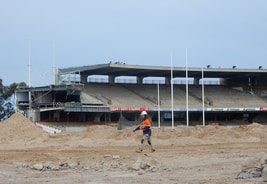 They 'Moved the Goal Posts"
They 'Moved the Goal Posts"
Persecution is not reserved for the Christian.
Allan Robinson, owned the salvage rights to the ‘The Gilt Dragon’ but in 1964 the Government ‘moved the Goal Posts’ in their favour and robbed him of his rights to the wreck and its substantial treasure.
Allan Robinson, owned the salvage rights to the ‘The Gilt Dragon’ but in 1964 the Government ‘moved the Goal Posts’ in their favour and robbed him of his rights to the wreck and its substantial treasure.
The Police Commissioner publicly disagreed with the court’s decision, and from then on Allan was harassed, persecuted by the media and ridiculed, by the man in the street who knew only what the media fed him. Time and time again Allan was accused of bazaar crimes. He fought them in court and was acquitted of every false charge. He never backed down, but things got so bad, it cost him his reputation, it cost him his marriage, it almost cost him his house, it cost him a fortune in legal fees and with a brief mental breakdown, it almost cost him his mind. But they never broke him!......
....Or did ‘they’ (whoever ‘they’ are). Isaiah 57:20 ... the wicked are like the troubled sea, When it cannot rest, whose waters cast up mire and dirt.
....Or did ‘they’ (whoever ‘they’ are). Isaiah 57:20 ... the wicked are like the troubled sea, When it cannot rest, whose waters cast up mire and dirt.
1983 November 2nd.
Three years after publishing his book:
Three years after publishing his book:
|
“In Australia Treasure is not for the Finder’ in which he complained about Police harassment, Allan was in prison, awaiting the jury’s verdict on the most bazaar of all the false charges laid against him ‘Conspiracy to murder’ based on one man’s testimony that Allan had said something that incriminated him.
|
Allan’s co-defendant his de-facto wife, had been acquitted of the same charge the day before and everyone, including Allan, was sure he would also go free. The prison guards said Allan was in good spirits at breakfast time, but about two hours later, the assembled court was informed Allan Robinson had hanged himself. The jury were stunned. The verdict has never been revealed and the bump on his head has never been explained.
HAROLD HOLT
An unlikely ally - Another shipwreck diver!
Harold Holt was the Patron of the Australian Underwater Federation, and he became Australia’s Prime Minister on 26 January 1966 and mysteriously disappeared while spear fishing on 17th Dec 1967.
Until 1967 Allan had an unlikely ally in another shipwreck diver, Harold Holt who, while he was our Commonwealth treasurer, said in the West Australian Newspaper 3rd May 1963
“It always seems to me ungenerous for any community to deprive those who find treasure and insist that it goes into the public coffers”
A comment that would not go down well with those who, quite frankly for whatever reason, were ‘out to get’ Allan Robinson.
“It always seems to me ungenerous for any community to deprive those who find treasure and insist that it goes into the public coffers”
A comment that would not go down well with those who, quite frankly for whatever reason, were ‘out to get’ Allan Robinson.
HAROLD HOLT CONSPIRACY
Here are some wild claims that Harold Holt was murdered.
https://www.harold-holt.net/Extracts_Nation_News.htm
https://www.harold-holt.net/Extracts_Nation_News.htm
The Demise of the 'Gilt Dragon'
by shipwreck treasure hunter Allan Robinson
(The man to whom I owe my life!)
READ THE STORY BELOW the NEWSPAPER CUTTING:
(This was the first of Allan Robinson's series about shipwrecks ....... The story of the ill fated 'Gilt Dragon' Published in the Hamersley News, Western Australia. Thursday 8th of January 1976)
Allan Robinson's story.
The book 'Treasure Lies Buried Here', which I read in my early teens, probably had a great influence on my decision to become an underwater explorer.
It gave information on all the known ship wrecks around the Australian coastline, with emphasis on wrecks in West Australian waters. By far the most romantic name which repeatedly appeared was the 'Gilt Dragon'.............................................
...............The Ship was built for the Chamber of Amsterdam in 1655. She was commissioned at Texel, Holland and sailed on her maiden voyage to Batavia on October 5 the same year.'
Her complement was 350 people; comprising merchants, sailors and adventures, as well as 60 soldiers, who were commissioned to 'keep, the peace aboard'.
Arriving at Cape Town on January 21, 1656, Captain Peter Alberts had to replace 105 souls who had perished at sea from scurvy .
Then, after taking on fresh stores, the ship sailed on January 28, on the final leg to Batavia. The trade merchandise she carried was mainly manufactured items — cloth, earthenware and building materials. A sideline for Captain's benefit only, was to buy elephant tusks in South Africa, which he could sell to Chinese merchants who carved them into ivory ornaments.
The 'Gilt Dragon' sailed south , from Cape Town to catch the 'Roaring Forties', then eastward for approximately three thousand miles, north-west for one thousand miles, then east again until the coast of the 'Great - South Land' — Australia — was sighted. The intention then was to catch the southerly winds to propel them on
to Batavia. Navigation at this time was primitive to say the least. The coast of Australia was only known to be in 'the proximity' and was sometimes sighted in daylight.
Unfortunately for the 'Gilt Dragon', she arrived at night. The first indication of trouble was the lookout's shout during a violent storm when, peering through the rain he saw huge breakers crashing onto a reef ahead.
The screamed warning to turn the cumbersome ship away came too late and the 'Gilt Dragon' reared into the waves and smashed onto
a reef, approximately 60 miles north of the Swan River.
The ship was rent asunder in darkness. Water poured aboard, timbers splintered, masts and rigging crashed to the decks.
Daylight brought a scene of complete chaos. Many of the passengers and crew had already disappeared over the side and others
had been crushed by moving cannons, cargo and timber. The Captain had the long-boat put over the side, only to see it
smashed to pieces in raging surf before anyone could clamber aboard. It was 10am before the next boat could be
successfully launched. Twenty people were crammed aboard, but the boat was swamped in the shallows and only three people reached the beach. The next boat did not make the same mistake of overloading and twelve people were safely landed. Throughout the day, the shuttle service of the two life-boats managed to rescue 75 people.
The next day the ship broke in half. One section,the entire stern, was carried north to sink, approximately 600 yards from the bow which
broke up where it foundered.
The survivors set up camp, picking up provisions as they floated ashore. The inhospitable coast could provide nothing for succour and
it was soon apparent that a rescue team had to be organised. One of the long boats was repaired, the sides raised and provisions put aboard.
The upper-steersman, Abraham Leaman van Santwits, was given the task of sailing the little fourteen foot life-boat, with six other helpers,
to Batavia, 3500 miles away, to report the catastrophe. Somehow, almost unbelievably, he made it, four months later. Two rescue ships
Were sent to search for survivors and recover the company's merchandise'. They were the 'Emeloort' and the "Wackende Buoy'.
The 'Emeoort' couldn't find her way and returned to Batavia. The 'Wackende Buoy', under Captain Volkersen, and with Abraham
Leaman van Santwits aboard, found the wreck site in February 1657.
It was not surprising that there was no sign of the survivors after 10 months. Indications were that foe camp site had beep visited by
natives who took foe survivors inland to a lake area where food and water were plentiful.
Two look-outs had been left in caves on high ground, three miles apart, in the hope that rescuers could be directed inland.
The skeletons of the two look-outs were found in 1931 by a survey party. Trinkets, coins and rosary beads were their only remaining possessions. The rest of the survivors were never located but settlers in the Moore River area in 1846 reported seeing light-skinned, ginger haired and freckle-faced aborigines. The wreck was never seen again until August 9, 1957, when in company with Bruce Phillips, a 16 year old student, I looked below me and sighted the remains of this once proud ship that never lived long enough to complete her maiden voyage.
The book 'Treasure Lies Buried Here', which I read in my early teens, probably had a great influence on my decision to become an underwater explorer.
It gave information on all the known ship wrecks around the Australian coastline, with emphasis on wrecks in West Australian waters. By far the most romantic name which repeatedly appeared was the 'Gilt Dragon'.............................................
...............The Ship was built for the Chamber of Amsterdam in 1655. She was commissioned at Texel, Holland and sailed on her maiden voyage to Batavia on October 5 the same year.'
Her complement was 350 people; comprising merchants, sailors and adventures, as well as 60 soldiers, who were commissioned to 'keep, the peace aboard'.
Arriving at Cape Town on January 21, 1656, Captain Peter Alberts had to replace 105 souls who had perished at sea from scurvy .
Then, after taking on fresh stores, the ship sailed on January 28, on the final leg to Batavia. The trade merchandise she carried was mainly manufactured items — cloth, earthenware and building materials. A sideline for Captain's benefit only, was to buy elephant tusks in South Africa, which he could sell to Chinese merchants who carved them into ivory ornaments.
The 'Gilt Dragon' sailed south , from Cape Town to catch the 'Roaring Forties', then eastward for approximately three thousand miles, north-west for one thousand miles, then east again until the coast of the 'Great - South Land' — Australia — was sighted. The intention then was to catch the southerly winds to propel them on
to Batavia. Navigation at this time was primitive to say the least. The coast of Australia was only known to be in 'the proximity' and was sometimes sighted in daylight.
Unfortunately for the 'Gilt Dragon', she arrived at night. The first indication of trouble was the lookout's shout during a violent storm when, peering through the rain he saw huge breakers crashing onto a reef ahead.
The screamed warning to turn the cumbersome ship away came too late and the 'Gilt Dragon' reared into the waves and smashed onto
a reef, approximately 60 miles north of the Swan River.
The ship was rent asunder in darkness. Water poured aboard, timbers splintered, masts and rigging crashed to the decks.
Daylight brought a scene of complete chaos. Many of the passengers and crew had already disappeared over the side and others
had been crushed by moving cannons, cargo and timber. The Captain had the long-boat put over the side, only to see it
smashed to pieces in raging surf before anyone could clamber aboard. It was 10am before the next boat could be
successfully launched. Twenty people were crammed aboard, but the boat was swamped in the shallows and only three people reached the beach. The next boat did not make the same mistake of overloading and twelve people were safely landed. Throughout the day, the shuttle service of the two life-boats managed to rescue 75 people.
The next day the ship broke in half. One section,the entire stern, was carried north to sink, approximately 600 yards from the bow which
broke up where it foundered.
The survivors set up camp, picking up provisions as they floated ashore. The inhospitable coast could provide nothing for succour and
it was soon apparent that a rescue team had to be organised. One of the long boats was repaired, the sides raised and provisions put aboard.
The upper-steersman, Abraham Leaman van Santwits, was given the task of sailing the little fourteen foot life-boat, with six other helpers,
to Batavia, 3500 miles away, to report the catastrophe. Somehow, almost unbelievably, he made it, four months later. Two rescue ships
Were sent to search for survivors and recover the company's merchandise'. They were the 'Emeloort' and the "Wackende Buoy'.
The 'Emeoort' couldn't find her way and returned to Batavia. The 'Wackende Buoy', under Captain Volkersen, and with Abraham
Leaman van Santwits aboard, found the wreck site in February 1657.
It was not surprising that there was no sign of the survivors after 10 months. Indications were that foe camp site had beep visited by
natives who took foe survivors inland to a lake area where food and water were plentiful.
Two look-outs had been left in caves on high ground, three miles apart, in the hope that rescuers could be directed inland.
The skeletons of the two look-outs were found in 1931 by a survey party. Trinkets, coins and rosary beads were their only remaining possessions. The rest of the survivors were never located but settlers in the Moore River area in 1846 reported seeing light-skinned, ginger haired and freckle-faced aborigines. The wreck was never seen again until August 9, 1957, when in company with Bruce Phillips, a 16 year old student, I looked below me and sighted the remains of this once proud ship that never lived long enough to complete her maiden voyage.
|
Western Australia in the 1960's was not only about Police corruption & War in Vietnam.
For me, the early 1960's in Western Australia was an exciting and surreal time. Hardly a day went by, without a News boy (not much younger than me) shouting out about treasure, shipwrecks, And I knew the finders! At the forefront of these reports was the ‘Gilt Dragon’ Just the name was enough to get a young man’s Adrenalin pumping, let alone its treasure (Worth today up to $20 mil). |
GILT DRAGON SHIPWRECK COINS
WESTERN AUSTRALIAN MUSEUM CERTIFIED
From one of my (Rex Woodmore) dives on the Gilt Dragon with Allan Robinson
I had several other coins that were stolen in a house burglary.
These remaining two coins are in safe keeping.
ABOVE: My Gilt Dragon Coins & Museum Certificates.
WHEN I DIVED ON THE 1656 WRECK of a
VOC TREASURE SHIP 'The GILT DRAGON'
Rex Woodmore
When I wore a younger man's wet suit (1960s):
I dived with Allan Robinson on the treasure of the Gilt Dragon, a 350 year old VOC Shipwreck with hundreds of artifacts: Chests of silver coins, elephant tusks, Cannon, earthenware jugs & ballast bricks. My first dive on the Gilt Dragon was almost my last! I was suddenly hit and picked up by a series of six 'King' waves that hurled me, time and time again, onto the ragged rocks.
I dived with Allan Robinson on the treasure of the Gilt Dragon, a 350 year old VOC Shipwreck with hundreds of artifacts: Chests of silver coins, elephant tusks, Cannon, earthenware jugs & ballast bricks. My first dive on the Gilt Dragon was almost my last! I was suddenly hit and picked up by a series of six 'King' waves that hurled me, time and time again, onto the ragged rocks.
In desperation I called out to the God that I didn't think I believed in!
This event was to leave an indelible imprint on my mind and eventually it made a dramatic difference to my way of life.
This event was to leave an indelible imprint on my mind and eventually it made a dramatic difference to my way of life.
READ THE FULL STORY HERE ON OZTREASURE 'I CALLED OUT"
WHO FOUND THE GILT DRAGON?
The official answer
There where lots of legal arguments going on about the discovery & salvage of the Gilt Dragon, but when I dived with Allan Robinson on the wreck, he had already obtained the legal rights to the salvage.
Tested in many legal fights, the courts agreed it was his treasure!
Allan Robinson legally claimed the discovery of the Gilt Dragon and he had the salvage rights to it.
Tested in many legal fights, the courts agreed it was his treasure!
Allan Robinson legally claimed the discovery of the Gilt Dragon and he had the salvage rights to it.
#AllanRobinson, #GiltDragon, #DutchShipwreck, #VOC, #FoundShipwreck, #LedgePoint, #WesternAustralianShipwreck, #BronzeCanon, #SilverCoins, #Treasure,
THE SHIP HITS THE REEF
The Gilt Dragon becomes a shipwreck.
28 April 1656, the Gilt Dragon struck a reef 5.6 kilometres off the coast of Western Australia.
On board were Bronze canon, Elephant tusks, thousands of Ballast bricks, Earthenware jugs, Eight chests of silver coins and a crew of 193 (118 drowned).
Seven brave men in a dinghy set off on a 1,400 nautical mile journey to seek help from Batavia. Amazingly they succeeded and reached their destination but sadly various rescue missions failed to find any trace of the remaining 69 castaways. The mystery remains to this day.
14 April 1963, the wreck of the Gilt Dragon was found at Ledge Point, Western Australia. It was the first discovery of five known 17th and 18th centuries VOC and English East India Company shipwrecks on the coast of Western Australian.
On board were Bronze canon, Elephant tusks, thousands of Ballast bricks, Earthenware jugs, Eight chests of silver coins and a crew of 193 (118 drowned).
Seven brave men in a dinghy set off on a 1,400 nautical mile journey to seek help from Batavia. Amazingly they succeeded and reached their destination but sadly various rescue missions failed to find any trace of the remaining 69 castaways. The mystery remains to this day.
14 April 1963, the wreck of the Gilt Dragon was found at Ledge Point, Western Australia. It was the first discovery of five known 17th and 18th centuries VOC and English East India Company shipwrecks on the coast of Western Australian.
1656 WRECK OF THE GILT DRAGON
(Vergulde Draeck) VOC TREASURE SHIP
GILT DRAGON
FAILED RESCUE ATTEMPTS
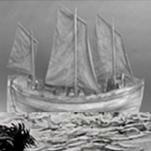 Artist impression of the small lifeboat.
Artist impression of the small lifeboat.
When the Gilt Dragon sank, with its crew of 193, only 75 of them made it to shore. A lifeboat with 7 of the survivors, was sent to Batavia for help. When they arrived in Batavia, two rescue ships were dispatched but failed to find any wreckage or the survivors.
To make matters worse they lost another 11 men & a boat in the search.
In January 1658 two other ships were sent out but were also unsuccessful. A boat from one of these ships disappeared but almost six months after having been given up as lost returned to Batavia.
To make matters worse they lost another 11 men & a boat in the search.
In January 1658 two other ships were sent out but were also unsuccessful. A boat from one of these ships disappeared but almost six months after having been given up as lost returned to Batavia.
GILT DRAGON RESEARCH GROUP
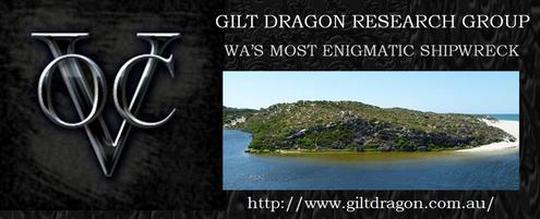 Gilt Dragon Research Group http://www.giltdragon.com.au
Gilt Dragon Research Group http://www.giltdragon.com.au
Gilt Dragon Research Group is a volunteer group of Scientists, headed by Steve Caffery, seeking to digitally record any and all information related to the Gilt Dragon wreck off the coast of Western Australia in 1656.
The Gilt Dragon Research Group take digital images of artefacts in private collections, record stories of adventure and discovery and preserve this information for future generations.
They do this because most artifacts were discovered in the 1960's causing a surge of interest and discovery. With time, many items of historical significance have been lost, relics are being used as doorstops, coins have been hidden away, and exciting stories of adventure have been forgotten. We wish to record images of artefacts and stories of discovery before they are lost forever.
The Gilt Dragon Research Group take digital images of artefacts in private collections, record stories of adventure and discovery and preserve this information for future generations.
They do this because most artifacts were discovered in the 1960's causing a surge of interest and discovery. With time, many items of historical significance have been lost, relics are being used as doorstops, coins have been hidden away, and exciting stories of adventure have been forgotten. We wish to record images of artefacts and stories of discovery before they are lost forever.
WHAT HAPPENED TO THE BRONZE CANNON?
I saw & touched at least one bronze cannon on the wreck.
 VOC Bronze Deck Cannon.
VOC Bronze Deck Cannon.
In trying to find out I came across a W.A. Museum publication that said there were no bronze cannon on the Gilt Dragon (?) I have not received a reply to my comment to them regarding the fact that I had seen and touched at least one bronze deck cannon on the wreck.
VOC CANNON FOR SALE!
2017 UPDATE: THE CANNON SUPERSTORE DEFUNCT
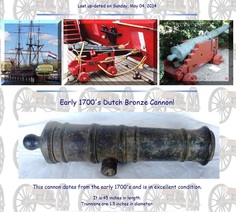 Screen Capture - Cannon Superstore.
Screen Capture - Cannon Superstore.
I came across a dealer - The Cannon Superstore
who did not know of any cannon from the 1656 Gilt Dragon but did tell me they have bought a lot of cannon from Australia (??)
On there website they say:
All Dutch VOC cannons are in great demand from collectors around the world and we sell them VERY FAST! Most of the ones we acquire are sold before they even appear on this website. If you want one of the cannons listed on this page - please do not hesitate to contact us or let us know exactly what you are looking for! This page changes almost every day. If you are looking for a reasonably priced VOC cannon, please bookmark this page and come back often!
who did not know of any cannon from the 1656 Gilt Dragon but did tell me they have bought a lot of cannon from Australia (??)
On there website they say:
All Dutch VOC cannons are in great demand from collectors around the world and we sell them VERY FAST! Most of the ones we acquire are sold before they even appear on this website. If you want one of the cannons listed on this page - please do not hesitate to contact us or let us know exactly what you are looking for! This page changes almost every day. If you are looking for a reasonably priced VOC cannon, please bookmark this page and come back often!
Response to a question:
2nd January 2015
My answer
To me the book filled in a lot of gaps during the time that I was in the Army (National Service) and lost I track of him.
Years later & the last time I saw Allan was on his birthday when I bumped into him in Subiaco. I jokingly said that I did not have a present for him. He opened the boot of his car and said
''I have a present for you!" opened a box and handed me a copy of his book which he had just picked up from the printers.
He signed it for me & that was it.
Sadly then I have since lost it. Perhaps I lent it to someone?
The book could be a good investment & a good read.
I found it was a little bitter & lacked Allan's usual great sense of humour. I liked Allan & I am indebted to him for risking his life to save mine on the wreck of the Gilt Dragon. Rex Woodmore
To me the book filled in a lot of gaps during the time that I was in the Army (National Service) and lost I track of him.
Years later & the last time I saw Allan was on his birthday when I bumped into him in Subiaco. I jokingly said that I did not have a present for him. He opened the boot of his car and said
''I have a present for you!" opened a box and handed me a copy of his book which he had just picked up from the printers.
He signed it for me & that was it.
Sadly then I have since lost it. Perhaps I lent it to someone?
The book could be a good investment & a good read.
I found it was a little bitter & lacked Allan's usual great sense of humour. I liked Allan & I am indebted to him for risking his life to save mine on the wreck of the Gilt Dragon. Rex Woodmore
ALLAN ROBINSON VINDICATED
The Gilt Dragon Treasure is rightfully his!
GILT DRAGON COINS - ILLEGAL TRADING
Today Tonight video.
THE GILT DRAGON WRECK SITE in 2015
|
Dave Jackson Published on Feb 26, 2015
www.facebook.com/divingwawrecks Diving the wreck site of the 1656 shipwreck of the Vergulde Draeck, also known as the Gilt Dragon. Wrecked off Ledge Point north of Perth in Western Australia. |
|
The site has been fully excavated and all that is left on the site it the cannons, anchors and some scattered building bricks. Photos included from the Western Australian Maritime Museum, Shipwreck Galleries Vergulde Draeck display.
DIVING ON SHIPWRECKS
THE LEGALITIES IN WESTERN AUSTRALIA
GILT DRAGON DIVING - PRIOR TO THE MUSEUM AMENDMENT ACT 1964
Before the Museum Amendment Act of 1964 had been introduced, the wreck of the Gilt Dragon was visited and dived on by many individuals including:
John Cowen; Allan Robinson; Jim, Alan and Graeme Henderson, followed by many individuals including local Cray fishermen, Divers from the Police diving squad, Navy divers and many of the members from the UEC (Underwater Explorers Club which included me (Rex Woodmore).
During this time, which was prior to the shipwrecks act (as it became known) and within the existing, or rather the non-existing, Maritime Archaeology laws of the time, many souvenirs were taken, quite legally, from the wreck. Later the museum requested that all items from wrecks, older than 1910, be taken to the museum for cataloguing. After which they were returned, together with valuable museum certification (at no cost) to the finders.
Before the Museum Amendment Act of 1964 had been introduced, the wreck of the Gilt Dragon was visited and dived on by many individuals including:
John Cowen; Allan Robinson; Jim, Alan and Graeme Henderson, followed by many individuals including local Cray fishermen, Divers from the Police diving squad, Navy divers and many of the members from the UEC (Underwater Explorers Club which included me (Rex Woodmore).
During this time, which was prior to the shipwrecks act (as it became known) and within the existing, or rather the non-existing, Maritime Archaeology laws of the time, many souvenirs were taken, quite legally, from the wreck. Later the museum requested that all items from wrecks, older than 1910, be taken to the museum for cataloguing. After which they were returned, together with valuable museum certification (at no cost) to the finders.
Prior to the museums involvement, souveniring by many individuals from all walks of life and salvage operations carried out by Allan Robinson, were considered to be quite legal. Unfortunately in the eyes of modern marine archaeologists it is considered and perhaps unfairly referred to as ‘’Looting”. If it was looting then the souvenirs would not have been returned to the so called ‘’looters’’ with the added value of museum certification, nor would Gilt Dragon artefacts seized by the C.I.B. from Allan Robinson have ever been returned to him.
According to the WA Museum:
The discovery of the Vergulde Draeck and the other significant pre-colonial wrecks was the catalyst for the development of maritime archaeology in Western Australia., a globally acknowledged centre of excellence in maritime archaeology.
The Museum has undertaken extensive excavation work at the Vergulde Draeck site and has painstakingly removed and conserved a wide range of material. The collection includes African elephant tusks, ballast bricks, beard man jugs, ceramic masks and medallions, clay tobacco pipes, bronze and brass utensils, various tools, glass bottles, an astrolabe and many silver coins.
When the secluded and pretty little township at the mouth of the Moore River was finally formally gazetted in 1951, the historian Henrietta Drake-Brockman recommended that it be named Guilderton in honour of the 'Gilt Dragon' and the thousands of guilders worth of silver coins it was carrying.
The discovery of the Vergulde Draeck and the other significant pre-colonial wrecks was the catalyst for the development of maritime archaeology in Western Australia., a globally acknowledged centre of excellence in maritime archaeology.
The Museum has undertaken extensive excavation work at the Vergulde Draeck site and has painstakingly removed and conserved a wide range of material. The collection includes African elephant tusks, ballast bricks, beard man jugs, ceramic masks and medallions, clay tobacco pipes, bronze and brass utensils, various tools, glass bottles, an astrolabe and many silver coins.
When the secluded and pretty little township at the mouth of the Moore River was finally formally gazetted in 1951, the historian Henrietta Drake-Brockman recommended that it be named Guilderton in honour of the 'Gilt Dragon' and the thousands of guilders worth of silver coins it was carrying.
Email Rex Woodmore: [email protected]


